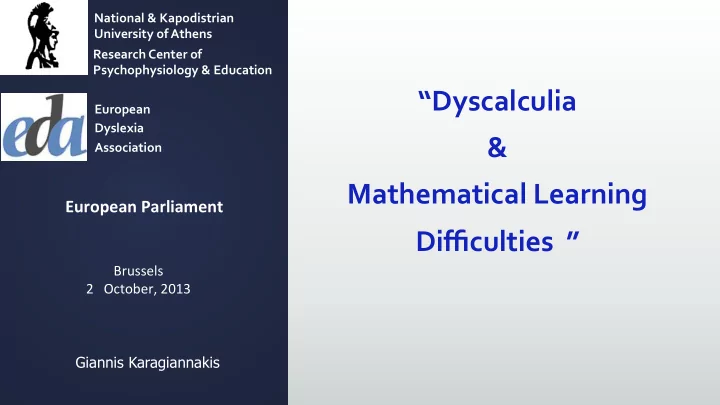

National ¡& ¡Kapodistrian ¡ ¡ University ¡of ¡Athens ¡ Research ¡Center ¡of ¡ ! Psychophysiology ¡& ¡Education ¡ “Dyscalculia ¡ ¡ European ¡ Dyslexia ¡ & ¡ ¡ Association ¡ Mathematical ¡Learning ¡ European ¡Parliament ¡ Difficulties ¡ ¡ ” ¡ Brussels ¡ 2 ¡ ¡ ¡October, ¡2013 ¡ ¡ Giannis Karagiannakis ¡
Poor ¡numerical ¡skills ¡ are ¡a ¡more ¡severe ¡handicap ¡ than ¡most ¡people ¡realize. ¡ ¡ ¡ ¡ A ¡recent ¡cohort ¡study ¡of ¡the ¡effects ¡of ¡ low ¡func4onal ¡ numeracy ¡ shows ¡that ¡‘it ¡is ¡more ¡of ¡a ¡handicap ¡in ¡the ¡ workplace ¡than ¡poor ¡literacy’ ¡ ¡ ¡ ¡ ¡ ¡ ¡ ¡ ¡ ¡ ¡ ¡ ¡ ¡ ¡ ¡ ¡ ¡ ¡ ¡ ¡ ¡ ¡ ¡ ¡ ¡ ¡ ¡ ¡ ¡ ¡ ¡ ¡ ¡ ¡ ¡ ¡ ¡ ¡ ¡ ¡ ¡ ¡ ¡ ¡ ¡ ¡ ¡ ¡ (Bynner ¡& ¡Parsons, ¡1997) ¡
Mathema'cs ¡demands’ ¡ ¡ Concepts ¡ ¡Number ¡Sense ¡ Meta-‑ cognition ¡ Math's ¡ ¡ Mathematical ¡Learning ¡ ¡ Language ¡ Logic ¡ Long-‑term ¡Memory ¡ Space ¡ ¡ ¡ Working ¡Memory ¡ ¡Facts ¡ Procedures ¡ ¡ ¡ retrieval ¡
D e v e l o p m e n t a l ¡ d y s c a l c u l i a ¡ i s ¡ tradiJonally ¡ defined ¡ as ¡ a ¡ disorder ¡ of ¡ numerical ¡competence ¡ and ¡ arithme4cal ¡ Developmental ¡ skills ¡ which ¡ is ¡ manifest ¡ in ¡ children ¡ who ¡ fail ¡ to ¡ achieve ¡ adequate ¡ proficiency ¡ in ¡ Dyscalculia ¡ this ¡ cogniJve ¡ domain ¡ despite ¡ normal ¡ intelligence, ¡proper ¡schooling, ¡emoJonal ¡ stability, ¡ adequate ¡ social ¡ environment, ¡ and ¡moJvaJon ¡ ¡(APA, ¡1994; ¡Shalev, ¡Manor, ¡& ¡Gross-‑ Tsur, ¡1997; ¡Temple, ¡1992). ¡
Epidemiological ¡studies ¡conducted ¡in ¡ several ¡ countries ¡ showed ¡ that ¡ this ¡ learning ¡ deficit ¡ is ¡ as ¡ widespread ¡ as ¡ Dyscalculia ¡ reading ¡ disorders ¡ and ¡ affects ¡ about ¡ Prevalence ¡ ¡ 3% ¡to ¡7% ¡ of ¡school-‑aged ¡children. ¡ ¡ ¡ ¡ (Badian, ¡ 1983; ¡ Gross-‑Tsur, ¡ Manor, ¡ & ¡ Shalev, ¡ 1996; ¡Kosc, ¡1974; ¡Koumoula ¡et ¡al., ¡2004; ¡Lewis, ¡ Hitch, ¡& ¡Walker, ¡1994; ¡Shalev, ¡2004; ¡Bu\erworth ¡ & ¡Reigosa-‑Crespo, ¡2007; ¡Reigosa-‑Crespo, ¡Valdés-‑ Sosa, ¡ Bu\erworth, ¡ Estévez, ¡ Rodríguez, ¡ et ¡ al., ¡ 2012; ¡Shalev, ¡2007). ¡
Comorbidity ¡ v ¡ ¡Dyscalculia ¡ 40% ¡-‑60% ¡ v ¡ ¡Dyslexia ¡ M athemaJcal ¡ L earning ¡ v ¡ ¡Dyspraxia ¡(DCD) ¡ ¡ D ifficulJes ¡ v ¡ ¡ADD-‑ADHD ¡ 25 ¡% ¡ ¡ ¡ ¡ ¡ ¡ v ¡ ¡Au4s4c ¡Spectrum ¡ v ¡ ¡Low ¡average ¡Intelligence ¡
¡ ¡ Single ¡Core ¡Deficit ¡ MLD ¡ Mul4ple ¡Deficit ¡Views ¡
¡ ¡ ¡ ¡ ¡ ¡ ¡ ¡ ¡ ¡ ¡ ¡ ¡ ¡ ¡ ¡ ¡ ¡ ¡ ¡ ¡ ¡ ¡ ¡ ¡ ¡MLD ¡classifica4on ¡ ¡ acute ¡-‑ ¡ ¡obtuse ¡– ¡concave ¡ 49 ¡ 71 ¡ 6 ¡x ¡7 ¡ 53 ¡-‑ ¡24 ¡ 3 3 ¡x ¡8 ¡ 7 ¡+ ¡7 ¡ even-‑ ¡odd ¡ numerator ¡-‑ ¡denominator ¡ 86 ¡+ ¡87 ¡= ¡__ ¡ 86 ¡+ ¡86 ¡= ¡172 ¡ (Karagiannakis ¡et ¡al, ¡2013) ¡
People ¡with ¡ poor ¡numerical ¡skills ¡ ( 26% ¡of ¡the ¡populaJon) ¡are: ¡ v ¡ more ¡than ¡two ¡and ¡half ¡4mes ¡ as ¡likely ¡to ¡be ¡ unemployed ¡ v more ¡than ¡three ¡and ¡half ¡Jme ¡as ¡likely ¡to ¡be ¡ depressed ¡ ¡ ¡ Compared ¡with ¡their ¡numerically ¡competent ¡peers: ¡ ¡ v ¡ twice ¡as ¡many ¡ are ¡in ¡ poor ¡physical ¡health ¡ v ¡fewer ¡than ¡half ¡ are ¡in ¡ employment ¡by ¡30 ¡years ¡old ¡ v ¡fewer ¡than ¡half ¡ are ¡home ¡owners ¡ ¡ ¡ ¡ ¡ ¡ ¡ ¡ ¡ ¡ ¡ ¡ ¡ ¡ ¡ ¡ ¡ ¡ ¡ ¡ ¡ ¡ ¡ ¡ ¡ ¡ ¡ ¡ ¡ ¡ ¡ ¡ ¡ ¡ ¡ ¡ ¡ ¡ ¡ ¡ ¡ ¡ ¡ ¡ ¡ ¡ ¡ ¡ ¡ ¡ ¡ ¡ ¡ ¡ ¡ ¡ ¡ ¡ ¡ ¡ ¡ ¡ ¡ ¡ ¡ ¡ ¡ ¡ ¡ ¡ ¡ ¡ ¡ ¡ ¡ ¡ ¡ ¡ (Parsons ¡& ¡Bynner, ¡2005). ¡
Thanks ¡ European ¡ www.eda-‑info.eu ¡ Dyslexia ¡ Associa4on ¡
Recommend
More recommend